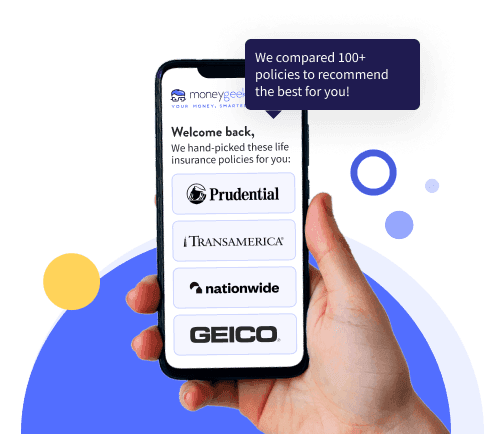Legal & General, Pacific Life, and Protective Insurance are the best young adult life insurance providers. Depending on your specific needs, other options may be better for you:
Best Life Insurance for Young Adults (2025)
Shopping for life insurance in your 20s? Smart move. Buying now means lower premiums, better coverage options, and easier approval. Legal & General, Pacific Life, and Protective Insurance are the best young adult life insurance companies in 2025.
Find out if you're overpaying for life insurance below.

Updated: December 1, 2025
Advertising & Editorial Disclosure
Legal & General is the best term life insurance company for young adult men, with average rates of $30 per month. For young adult women, the best option is Assurity, with average rates of $22 per month.
Pacific Life offers the best no-exam policies for young people, with $3 million maximum coverage, while Protective Insurance offers the best rates for 20-25 year olds at high coverage levels of $1 million and higher.
North American is the best whole life insurance for young adults, with average rates at $281 for 25-year-old women and $347 for men.
Ensure you are getting the best rate for your insurance. Compare quotes from the top insurance companies.
Why You Can Trust MoneyGeek
We analyzed 248,399 life insurance quotes from 29 insurance companies covering ages 18 to 30 for smokers, non-smokers, men, and women at various heights, weights, and health levels across a range of term limits and coverage levels. MoneyGeek maintains editorial independence and doesn't receive compensation from insurance companies for life insurance rankings or recommendations. For more information, read our full methodology.
Best Life Insurance Companies for Young Adults
Legal & General | Term: $26 (F), $30 (M) | 20 | 10-40 years | Yes | 4.7 | |
Pacific Life | Term: $26 (F), $30 (M) Whole: $313 (F), $377 (M) | 18 | 10-30 years | No | 4.7 | |
Protective Insurance | Term: $23 (F), $29 (M) Whole: $308 (F), $350 (M) | 20 | 10-40 years | Yes | 4.6 | |
Assurity | Term: $22 (F), $30 (M) | 18 | 10-30 years | No | 4.6 | |
Guardian Life | Term: $27 (F), $33 (M) | 18 | 10-30 years | Yes | 4.5 | |
North American | Term: $22 (F), $28 (M) Whole: $281 (F), $347 (M) | 18 | 10-30 years | Yes | 4.5 |
* Rates shown here are for healthy, non-smoking 25-year-olds of average height and weight at $500,000 coverage on 20-year terms. Your rates will vary by state, health profile, coverage needs, and other factors. Compare personalized quotes from multiple providers to get the best rates.
Best Life Insurance for Young Men

Avg. Monthly Rate (Term)
$26 (F), $30 MMin. Supported Age
20Term Lengths
10-40
- pros
Affordable rates
High coverage limit up to $10 million
Strong financial stability with A AM Best rating
Comprehensive rider options
consMedical exam required
Legal & General is the best life insurance option for young men, offering competitive rates and comprehensive coverage options. Men in their early 20s pay an average of $30 monthly for 20-year term policies at $500,000 coverage. High coverage limits are available up to $10 million with terms ranging from 10 to 40 years.
- A.M. Best rating: A
- NAIC complaint index: 0.35
- J.D. Power score: N/A
- Customer sentiment: 85% positive, 15% negative
- Max coverage: $10 million
- Medical exam required: Yes
- Terms available: 10 to 40 years
- Ages supported: 20 to 75
- Riders and options: Accelerated death benefit rider, child rider, stacking rider, guaranteed insurability rider, conversion options to age 70
Best No-Exam Young Adult Life Insurance

Avg. Monthly Rate (Term)
$25 (F), $30 (M)Avg. Monthly Rate (Whole)
$313 (F), $377 (M)Min. Age Supported
18Term Lengths
10-30 years
- pros
No medical exam required
Strong financial stability with A AM Best rating
Flexible term lengths up to 30 years
consLower customer sentiment at 72% positive
Max no-exam coverage capped at $3 million
Pacific Life has the best no-exam life insurance for young adults, offering coverage up to $3 million without a medical exam. Young adults can secure a $500,000 term policy for $25 to $30 monthly. Pacific Life provides flexible term lengths from 10 to 30 years, accepting applicants as young as 18 years old.
You can customize your policy with riders, including accelerated death benefit, child term coverage, waiver of premium and guaranteed insurability.
- A.M. Best rating: A
- NAIC complaint index: 0.08
- J.D. Power score: 657 (7th)
- Customer sentiment: 72% positive, 28% negative
- Max coverage: $10 million+, or $3 million without medical exam
- Medical exam required: No
- Terms available: 10 to 30 years
- Ages supported: 18 to 75
- Riders and options: Accelerated death benefit, child term rider, waiver of premium, accidental death benefit, guaranteed insurability, conversion options
Best High Coverage Life Insurance for Young Adults

Avg. Monthly Rate (Term)
$23 (F), $29 (M)Avg. Monthly Rate (Whole)
$308 (F), $350 (M)Min. Age Supported
20Term Lengths
10-40 years
- pros
Competitive rates for coverage of $1 million or more
Coverage limits exceeding $10 million
Affordable whole life options starting at $59 monthly
Term lengths up to 40 years
consMedical exam required
No NAIC complaint index data available
Protective Insurance is a great choice for young adults seeking high coverage levels of $1 million or more, with competitive rates and coverage limits exceeding $10 million. Young men pay $29 monthly on average for $500,000 term policies, while women save even more at $23 monthly.
Protective Insurance holds an A+ rating from AM Best and also scored 653 in J.D. Power's customer satisfaction survey.
- A.M. Best rating: A+
- NAIC complaint index: N/A
- J.D. Power score: 653 (9th)
- Customer sentiment: 82% positive, 18% negative
- Max coverage: $10 million+
- Medical exam required: Yes
- Terms available: 10 to 40 years
- Ages supported: 20 to 80
- Riders and options: Child term rider, accelerated death benefit, waiver of premium, accidental death benefit, guaranteed insurability, conversion options up to age 70
Best Life Insurance for Young Women and Smokers

Avg. Monthly Rate (Term)
$22 (F), $30 (M)Min. Age Supported
18Term Lengths
10-30 years
- pros
Lowest smoker rates we quoted
No medical exam required
Unique riders available
Coverage exceeds $10 million with standard underwriting
consNo-exam coverage limited to $1 million
Lower AM Best rating of A-
Higher NAIC complaint index of 0.638
Assurity is the best life insurance for young women and smokers, offering flexible underwriting, affordable rates, and extensive rider options. Nonsmoking young women pay just $21 to $22 monthly for term coverage, while smokers pay $60 to $62.
The company maintains an A- rating from AM Best for financial stability. Its NAIC complaint index is also higher at 0.638, though we found 85% positive customer sentiment in review forums.
- A.M. Best rating: A-
- NAIC complaint index: 0.638
- J.D. Power score: N/A
- Customer sentiment: 85% positive, 15% negative
- Max coverage: $10 million+, or $1 million without a medical exam
- Medical exam required: No
- Terms available: 10 to 30 years
- Ages supported: 18 to 75
- Riders and options: Accelerated death benefits rider, return of premium rider, accident only disability income rider, critical illness rider, disability income rider, level term rider
Best Customer Experience

Avg. Monthly Rate (Term)
$27 (F), $33 (M)Min. Supported Age
18Term Lengths
10-30 years
- pros
Highest possible A++ AM Best rating
Second place J.D. Power customer satisfaction ranking
Unique charitable benefit rider
90% positive consumer sentiment
consSlightly higher premiums
Medical exam required
Guardian Life earns our top spot for customer experience with a 4.9 MoneyGeek customer experience score. Young adults pay $27 to $33 monthly for term coverage, with Guardian Life offering policies up to $5 million and terms from 10 to 30 years for applicants starting at 18 years old.
Guardian Life holds the highest possible A++ rating from AM Best and receives 92% fewer complaints than the industry average with a 0.08 NAIC complaint index.
- A.M. Best rating: A++
- NAIC complaint index: 0.08
- J.D. Power score: 685 (2nd)
- Customer sentiment: 90% positive, 10% negative
- Max coverage: $5 million
- Medical exam required: Yes
- Terms available: 10 to 30 years
- Ages supported: 18 to 75
- Riders and options: Charitable benefit rider, waiver of premium, guaranteed renewability
Best Whole Life Insurance for Young Adults

Avg. Monthly Rate (Term)
$22 (F), $28 (M)Avg. Monthly Rate (Whole)
$281 (F), $347 (M)Min. Supported Age
18Term Lengths
10-30 years
- pros
Most affordable whole life rates for 20-year-olds
A+ AM Bast financial strength rating
Competitive term life rates
consMedical exam required
Lower customer sentiment at 77% positive
Limited information on available riders
North American has the best whole life insurance for young adults with highly competitive premiums and strong financial ratings. Young adults pay just $66 to $70 monthly for $500,000 whole life policies at age 20, making permanent protection affordable if you’re just starting a career. These rates increase substantially for 25-year olds, up to $281 for women and $347 for men, but they’re still among the most affordable for the age. North American also offers term policies for an average of $20 to $28 monthly for $500,000 in coverage.
North American holds an A+ rating from AM Best, showing the financial strength to honor lifelong policies. Across review forums, they have 77% positive customer sentiment, which is slightly lower than other options in our list. Though North American requires a medical exam, its affordable whole life premiums suit young adults who want permanent coverage that builds wealth.
- A.M. Best rating: A+
- NAIC complaint index: N/A
- J.D. Power score: N/A
- Customer sentiment: 77% positive, 23% negative
- Max coverage: $10 million+
- Medical exam required: Yes
- Terms available: 10 to 30 years
- Ages supported: 18 to 60
- Riders and options: N/A
Average Cost of Young Adult Life Insurance
For young adults, term life insurance costs $20 to $35 monthly, with women paying less than men across all insurers. North American offers the lowest term rates, while Guardian Life charges the most. Whole life insurance is more expensive, starting at $59 for 20-year-old women and $70 for men.
Assurity | $21 (F), $30 (M) | $22 (F), $30 (M) | $23 (F), $30 (M) | N/A | N/A | N/A |
Protective Insurance | $21 (F), $28 (M) | $23 (F), $29 (M) | $24 (F), $30 (M) | $59 (F), $84 (M) | $308 (F), $350 (M) | $403 (F), $433 (M) |
North American | $20 (F), $27 (M) | $22 (F), $28 (M) | $24 (F), $29 (M) | $66 (F), $70 (M) | $281 (F), $347 (M) | $361 (F), $432 (M) |
Pacific Life | $25 (F), $30 (M) | $26 (F), $30 (M) | $27 (F), $30 (M) | $78 (F), $81 (M) | $313 (F), $377 (M) | $396 (F), $455 (M) |
Legal & General | $26 (F), $30 (M) | $26 (F), $30 (M) | $26 (F), $30 (M) | N/A | N/A | N/A |
Guardian Life | $27 (F), $33 (M) | $27 (F), $33 (M) | $27 (F), $35 (M) | N/A | N/A | N/A |
* Your actual rates may vary based on health, lifestyle, and other factors. Request quotes from multiple companies when researching the best life insurance plans for you.
What is the Best Type of Life Insurance for Young Adults?
Term and permanent (which includes whole and universal) are the two main types of life insurance. Term life insurance is usually the best option for young adults, allowing you to secure lower rates while you're young and healthy. Select a plan that lasts 20 or 30 years to protect your loved ones from financial challenges if you pass away unexpectedly.
Guarantees a Death Benefit | Yes | Yes |
Allows Access to Living Benefits | Limited (accelerated death benefit only) | Yes (multiple options) |
Coverage Length | 10-40 years | Your entire life |
Premium Cost | Affordable | More expensive |
Change in Premium Cost | May remain the same or may increase over time, depending on what type you get | Remains the same over time |
Earns Cash Value | No | Yes, cash value accumulates over time |
Eligible for Dividends | No | Yes, depending on the insurer |
Allows for Withdrawals While Policy Is in Effect | No | Yes, but loans will cause the death benefit to be reduced if unpaid |
Requires a Health Exam | Depends on the insurer | Depends on the insurer |
Best Young Adult Life Insurance: Bottom Line
Young adult life insurance costs $20 to $35 monthly for term coverage, making it affordable to protect your family during your peak earning years. Legal & General leads for young men at $30 monthly, while Pacific Life offers no-exam policies up to $3 million and Assurity provides the lowest rates for women and smokers. Protective Insurance excels for high coverage needs above $1 million with an A+ rating, and Guardian Life delivers top-tier customer service. North American offers the most affordable whole life policies starting at $66 monthly, though term insurance usually makes more sense for young adults building financial protection.
Ensure you are getting the best rate for your insurance. Compare quotes from the top insurance companies.
Life Insurance for Young Adults: FAQ
We answer common questions about getting life insurance as a young adult. Although life insurance may seem unnecessary right now, this financial safeguard will protect your loved ones if you die unexpectedly.
Why should you get life insurance at a young age?
Buying life insurance at an early age offers several benefits. You're more likely to be in better health, which lets you get lower rates. If you choose a permanent life plan, buying life insurance earlier also gives you more time to let your policy earn cash value.
How young can you get life insurance?
The earliest age you can get life insurance is 18 years old based on the companies we reviewed. Some providers offer an optional add-on called a child rider that provides a small amount of life insurance coverage for children under an adult’s policy.
Is life insurance cheaper when you’re younger?
Yes, life insurance rates are more affordable when you purchase your policy at a young age. If you choose a term life plan, you're more likely to outlive the policy. You'll also be less likely to have health conditions, which leads to insurers offering lower rates.
Our Review Methodology
Finding the right life insurance in your 20s feels overwhelming when you're already juggling student loans, career changes and maybe starting a family. That's why we built our research specifically around what matters most to young adults: affordable premiums that won't strain your budget and straightforward coverage.
Our Scoring Framework
We evaluated insurers using three key factors, weighted to reflect young adult priorities:
- Affordability (50%): How do the company’s rates compare to other providers for similar coverage?
- Customer Experience (30%): We analyzed customer complaint data from the National Association of Insurance Commissioners (NAIC), AM Best financial strength ratings, and consumer sentiment among popular review forums. We also evaluated digital tools and payment flexibility since young adults typically prefer online management and multiple payment options.
- Coverage Options (20%): We considered available plan types, coverage limits, age restrictions, term lengths, riders, and other customization options.
Each company earned up to five points in each category. We then converted these category scores into a weighted overall score out of five points using our percentage weightings.
Sample Profile Details
We gathered 248,399 life insurance quotes using a standard young adult profile:
- Ages 18 to 30
- Nonsmoker
- Average health level
- Average height
- Average weight
- Multiple coverage amounts from starter policies to family protection
- Various term lengths to match different financial timelines
We modified this profile by age, gender, health rating, and location to capture rate variations across the young adult demographic. This approach revealed pricing patterns that help predict what you'll actually pay. Unless otherwise specified, rates shown throughout this article are for healthy, non-smoking 25-year-olds of average height and weight.
Related Articles
About Mark Fitzpatrick

Mark Fitzpatrick, a Licensed Property and Casualty Insurance Producer, is MoneyGeek's resident Personal Finance Expert. With over five years of experience analyzing the insurance market, he conducts original research and creates tailored content for all types of buyers. His insights have been featured in publications like CNBC, NBC News and Mashable.
Fitzpatrick holds a master’s degree in economics and international relations from Johns Hopkins University and a bachelor’s degree from Boston College. He's also a five-time Jeopardy champion!
He writes about economics and insurance, breaking down complex topics so people know what they're buying.




